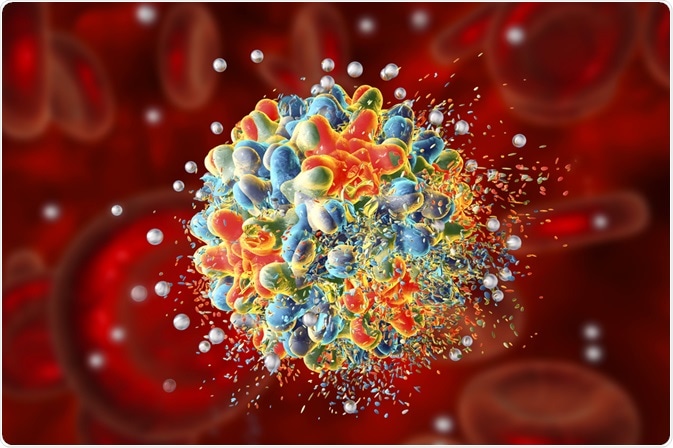Nanoparticles possess a diameter of 1–100 nm, and can be of a variety of shapes and sizes. They can be made from several organic or inorganic materials and can be used in vivo for drug delivery, biosensing, or bioimaging.
These applications require the nanoparticles to localize to a specific tissue or cell type, for which a biomimetic coating can interact with the cell membrane of the target.
Membrane-coated nanoparticles provide improved retention time and a method of targeting specific cells or tissues within the body.
 Image Credit: Kateryna Kon / Shutterstock
Image Credit: Kateryna Kon / Shutterstock
Stealth nanoparticles
Increasing retention time
Nanoparticles are attracting increasing interest as contrast agents and drug delivery vehicles, particularly in cancer treatment, where the ability to deliver a mixed payload of drugs directly to the cytoplasm or nucleus of a cancer cell is highly valued. However, several types of nanoparticles are quickly eliminated by the reticuloendothelial system due to the interaction with other proteins present in a biological setting.
Coating these particles with a biocompatible molecule such as polyethylene glycol (PEG) drastically improves the retention time of the nanoparticle, granting stealth properties. The addition of certain biomolecules to the exposed surface of the nanoparticle or its dense PEG coating can improve retention time further.
Red blood cells coated with various proteins, such as transmembrane protein CD47 mark them as belonging to the body, exempting them from elimination. These proteins can be attached to a nanoparticle, greatly prolonging retention time.
Nanoparticles against autoimmunity
Staphylococcus aureus secretes α-hemolysin, a hemolytic toxin that attacks red blood cells. Nanoparticles coated with red blood cell proteins can act as decoys, form a complex with this toxin and neutralize it, leaving healthy red blood cells unharmed.
This decoy strategy has also been shown to be successful in autoimmune hemolytic anemia, diverting anti-red blood cell antibodies away from healthy cells.
Active targeting using membrane-coated nanoparticles
Coating nanoparticles with leukocyte membrane proteins improves the retention time, similar to the addition of red blood cell proteins.
This also has the advantage of encouraging movement towards the tumor via inflammation chemotaxis in addition to enhanced cancer cell penetration due to functional membrane molecules.
Personalized medicine
Cancer cells tend to overexpress particular membrane proteins responsible for the transport of biomolecules across the cell membrane, depending on the specific mutation of the cancer cell.
Predetermining which proteins are overexpressed on the cancer cells of a patient create personalized medicine, where drug-bearing nanoparticles are functionalized with complementary proteins that will interact with these overexpressed membrane proteins, resulting in internalization.
Immune modulation
Membrane-coated nanoparticles can be used in vaccine design for bacterial immunity. This can be achieved through gradual sequestration of bacterial toxins or mimicking the presence of the bacteria through antigen presentation.
The complex biological characteristics of the particular bacteria are maintained on the nanoparticle surface, and this encourages the body to elicit strong immune responses.
Incorporation of active targeting and stealth coatings improve the efficacy by the programmed release in a specific organ or tissue.
Further Reading